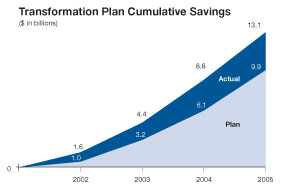 |
page 26 of 87 |  |
II. REDUCE COSTS
By operating as a much leaner, more efficient organization, the Postal Service has been able to improve service at the same time it recorded significant gains in productivity and reductions in cost. The cumulative cost savings under Transformation will be at least $13 billion by the close of 2005. Total Factor Productivity has improved for five consecutive years, and is on track to increase again for a record sixth straight year in 2005.

By the end of 2004 the Postal Service had cut outstanding debt by $9.5 billion, to the lowest debt level since 1984. More than 5.5 million new delivery points have been added since 2002, roughly equivalent to the number of delivery addresses in the state of Ohio. Over the same period, 465 million fewer workhours were used. Career staffing has declined to the extent that it now stands at pre-1985 levels, when the Postal Service delivered 57 percent less mail than today.
Postal prices are driven by operating costs, and reasonable postage rates are the ultimate result of sound cost management. Along with reliable service, maintaining affordable products is the most important measure of success for postal customers. The Postal Service's cost saving achievements under Transformation and legislated changes in the Postal Service's contribution to the Civil Service
Retirement System have helped hold postage rates steady from mid-2002 until 2006.
STRATEGY: IMPROVE OPERATIONAL EFFICIENCY
Expand standardization and process control. Reduce the cost of meeting universal service obligations by focusing on major cost drivers, especially delivery operations. Fully capture improvements from existing equipment and technology and target new investments to further drive productivity gains. Continue to partner with customers to minimize total cost and to develop new, low-cost forms of customer access using technology and product simplification. Examine facility capacities to consolidate operations and transition from overlapping single-product networks to an integrated multi-product network.